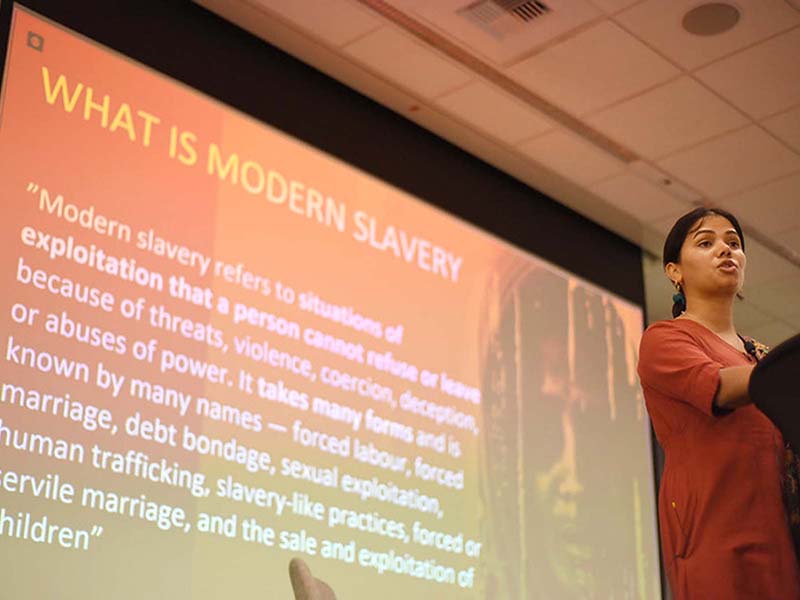
Business Transformation | Human Rights | Stakeholder Engagement
Community Engagement: A Cornerstone of Effective Stakeholder Engagement
BSR explores international standards governing company responsibilities to community members, the business value of community engagement, and practical tips for conducting it.

Business Transformation | Human Rights | Stakeholder Engagement
Effective Stakeholder Engagement: Ensuring Internal Company Alignment
BSR shares key actions to ensure internal alignment ahead of stakeholder engagement: establishing an overarching vision, identifying internal ownership, shifting from ad hoc to ongoing engagement, and balancing transparency and legal risk.

Human Rights | Responsible Technology
From Innovation to Impact: Key Takeaways from the 2025 Tech Against Trafficking Summit
BSR shares takeaways from the 2025 Tech Against Trafficking Summit, where participants discussed how innovative technology, increasingly driven by AI, can be a powerful enabler to fight modern slavery when responsibly and carefully designed and deployed.

Business Transformation | Just Transition | Regulations
How Stronger Just Transition Policies Can Enable Business Action
In the shift toward a net-zero economy, advancing a just transition is both a social and business imperative. BSR and We Mean Business outline 12 policy asks to guide business engagement on the just transition and drive investment in equitable transformation.

Climate And Nature | Csddd | Human Rights | Regulations
EU Omnibus: Challenges and Opportunities of the Parliament’s Proposed Changes to the CSDDD
BSR shares key changes in the CSDDD based on the EU Omnibus, next steps in the legislative process, and actions companies can take to drive long-term value and resilience.

Human Rights | Regulations | Stakeholder Engagement
Stakeholder Engagement in a Changing Business Landscape
While stakeholder engagement is a legal imperative reinforced by regulations, its business value extends far beyond compliance. BSR shares how stakeholder engagement can help companies protect their ability to operate and contribute to broader community resilience and societal progress.

Human Rights | Regulations | Responsible Technology
The CSDDD: Implications for the Tech Sector
The EU’s Corporate Sustainability Due Diligence Directive will impose new due diligence requirements on large companies operating in the EU. BSR shares human rights risks most relevant to tech companies and outlines practical steps they can take now to prepare.

Climate And Nature
Climate Week 2025: The World Shows Up at A Critical Time
This year’s Climate Week was the biggest in its 16-year history, with more than 1,000 events, a high level of government participation, and a noteworthy level of business engagement. BSR President and CEO Aron Cramer shares four takeaways from the event.

Climate And Nature
From Scopes to Spheres: Advancing Climate and Nature Integration
Amid converging systemic challenges and worsening climate impacts, it is crucial that companies take an integrated approach to climate action. BSR shares insights from its climate and nature integration working group on how businesses can align operational resilience with environmental stewardship and social well‑being.

Climate And Nature | Just Transition
From the Backseat to the Front Row: The Urgent Need for Adaptation
As climate change and nature degradation accelerate in intensity and frequency, building resilience has never been more urgent. BSR shares seven practical steps companies can take today to pursue climate adaptation and resilience.

Business Transformation | Climate And Nature | Stakeholder Engagement | Supply Chain
From the Frontlines of Scope 3: Key Lessons from Supplier Engagement Initiatives
For companies tackling their Scope 3 emissions, practical guidance for engaging with suppliers on climate is critical. BSR shares three key takeaways on effective supplier engagement strategies, based on insights from companies who participated in the Supplier Cascade collaboration.

Business Transformation | Human Rights | Stakeholder Engagement | Supply Chain
Partnering with Suppliers to Advance Human Rights Due Diligence
Evolving regulatory frameworks and rising stakeholder expectations are prompting companies to move beyond one-size-fits-all compliance and collaborate with suppliers to strengthen human rights across the value chain. Discover practical tools for fostering a partnership-based approach to human rights due diligence and examples of effective supplier engagement models.

Business Transformation | Human Rights | Sustainability Reporting
What’s Next? Building on a Corporate-Level Human Rights Assessment
Human Rights Assessments are foundational to the due diligence process, but real impact comes from embedding HRA findings into daily operations, governance, and strategy. BSR share six key steps companies can take to move beyond one-time assessments and build credible due diligence approaches that strengthen risk management and deliver positive outcomes for both people and business.

Climate And Nature | Energy And Extractives | Human Rights
Mining and the Just Transition: Putting People at the Center of the Energy Transition
The mining industry plays a dual role in climate change as both a contributor of greenhouse gas emissions and enabler of the clean energy transition. Explore key actions companies can take to facilitate a just transition, as mining expands with the growing demand for renewable energy technologies.

Climate And Nature | Human Rights | Regulations
Developing Integrated Approaches to Human Rights, Climate, and Nature
Siloed operational frameworks, data issues, and limited guidance on how EU-wide sustainability regulations interact hinder effective human rights and environmental due diligence. BSR shares insights and emerging good practices for integrated approaches to human rights, climate, and nature.